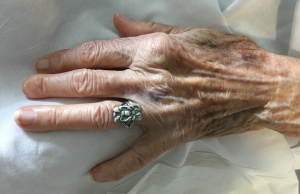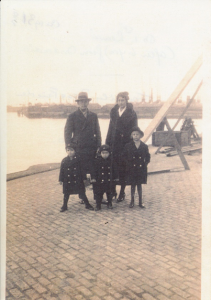- Bastiaan “Bart” M. Drees, July 29, 2016

A hand can tell you so much about a life well lived. My mom was born on Aug. 10, 1925 and recently passed away on June 18, 2016 at the age of 90. Her long life led her from the Netherlands to Indonesia (the Dutch East Indies), back to the Netherlands (Holland) where she survived World War II, and then to Texas where she lived in Dallas and later Austin. Her hand shows the wrinkles and arthritis of age and years of weeding in her landscape during her years living in the “Lake House” (3910 Conejo Circle) in Austin. Her middle finger is missing the tip and nail from a wind gust slamming the door shut while her hand was in the door frame.
However, the most prominent feature of her left hand is the silver ring that she wore for most of her adult life, which tells a story that should be preserved. Three months after she was born, her Dutch parents moved to Indonesia where her brothers Henk (1927-1980) and Johan or “Joop” (1928-2012) were born. Over the next few years, she and her brothers were moved from location to location with their parents. Her dad (my grandfather and namesake), Bastiaan Leendert Vaandrager (1900-1948), had earned his degree to become a medical doctor with a loan provided by the Dutch army. He had agreed to serve in the Army as a medical officer in the Dutch colony, and thereafter was moved seven times, as he served his time. Today, his kids would be called “Army brats.” He had a passion for orchids, and each time the family moved, they would be accompanied by big crates of his plants, much to the chagrin of his wife, Froukje “Frieda” Ebes Vaandrager (1903 – 1947).

In 1940, World War II broke. After returning to Holland briefly, my mom (Jacoba, “Jacky”), and her brother Henk were separated from ther parents and youngest brother who had returned to Indonesia. The Nazis invaded and occupied the Netherlands, bombing Rotterdam on my aunt’s (Ali Meijer Drees, “Tante Zus”) 16th birthday. The Japanese Army overtook and occupied Indonesia. My Mom attended 3 high schools and stayed with her grandparents on both sides of her family (in Rotterdam – Ebes side, and in Driebergen – the Vaandrager side) and with uncle Henk Ebes (Amsterdam) during the war years, 1940-1945. She worked on a farm near Amsterdam during the last, “hunger year” of the war.
In Indonesia, her dad was put in a Japanese prison camp for adult men while his wife and youngest son were put into a camp for women and children. However, when Joop turned 16, he was separated from his mother and placed in a different camp for men. When he arrived, there was no room for another bed in the overcrowded camp. He was told to sleep on the wooden foot bridge over the ditch that led to and drained the latrine. He was provided only water and bread rations. When he got out of prison camp at the age of 17, he weighed 75 pounds, having survived by eating wild hot peppers growing on the prison grounds.
After the war, Mom was re-united with her mom, dad and Joop. They were offered a room in her mom’s brother’s home, Uncle (“Om” in Dutch) Henk, an oral and plastic surgeon. During the years that followed, Mom’s mom died of breast cancer in 1947, and her Dad died suddenly of a brain hemorrhage a year later. Her brother, Joop, was studying to finish high school and later to become a medical doctor like his dad had been.
Joop had obtained a silver ring (by loan from an unknown woman) which was designed by Dutch artists, made by Indonesian craftsmen and sold in a Hindu Temple in Djokjakarta. His uncle Henk taught him how to make a mold of the ring’s artwork that depicted an orchid, his dad’s favorite flowering plant (which later also became Joop’s favorite plant during the years he spent in Garland, Texas as a general practitioner). The process, similar to that of making crowns for teeth, involves making a copy of the ring from the mold using wax. This wax replica is then placed in Plaster of Paris with a hole connecting the wax mold to the surface. When heated, the wax melts and drains out of the plaster. Then molten silver can be poured into the hole and cooled in the cavity where the wax had been. This process is called the lost wax technique.
Joop gave the ring to my Mom for her (20th or 21st) birthday, and she never again took it off for very long. It was a reminder to her of so many parts of her young life, her family, and all they had gone through. Later in life, she struggled to decide what to do with this possession, which she treasured more than just about anything else. She finally came to a conclusion: she wanted to give it to her brother Joop’s youngest daughter, Janneke. The main reason was that her name, Janneke, is the feminine form of Johan, and her middle name is derived from Kia Helbertsma, Joop’s wife’s family name. Janneke reminded mom the most of her brother.
Knowing that this ring would be willed to Janneke, I had a crazy idea. Mom had been hospitalized on June 2, 2016 with a blocked intestine. Then the doctor had discovered metastatic breast cancer in her spine and hip which was causing a lot of pain. When I visited Mom in the hospital on June 7, we both knew that time may be running out because no nourishment could be provided to her without causing a serious reaction. However, she was completely lucid and understood exactly what was happening to her. She had decided not to undergo surgery to resolve the blockage, hoping that, perhaps, it would resolve itself. There were no signs that that would happen, however. I talked to her for over two hours that evening, covering a wide range of topics, including politics, current events, family stories, and of course, the ring. Finally, I said, “Mom, I have this crazy idea. Will you work with me to make it happen?” She was intrigued and went along after hearing my plan. I had brought some clay from the ceramics shop I have been working in since retiring in the fall of 2013. I took it out and had her make a fist with her right hand, allowing me to make an impression of her fingers and Joop’s ring – where it had been all of her life. I took the (negative) impression back to the ceramic’s shop and had it fired. This allowed me to fill that impression with clay pressed into the mold and have an exact (positive) impression of her fist – and the ring.
My mom was always a fighter. If she had a grave stone, she always said it should read, “Always the hard way.” And, to me, this replica of her fist and her ring will forever remind me of her character: tenacity and love of her family. Moreover, I can now make multiple copies for my daughters and other relatives with whom I intend to share this story. Even though the ring is now a copy of a copy, ceramic artifacts have a permanence far exceeding the short period of the time each of us has on this planet. I am betting that her story and legacy will last a very long time.
